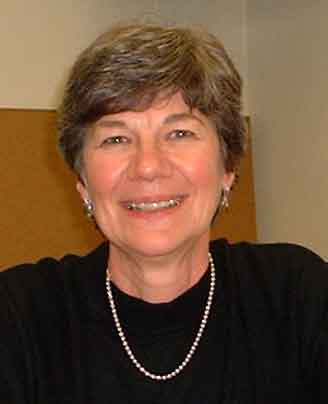Faculty,
Management/Computer Information Science
Back to ARC Institutional Report index

|
Interview with Sherrill Kulp Faculty, Management/Computer Information Science Back to ARC Institutional Report index |
 |
Participatory style: Many more faculty member do use participatory learning style than 10 years ago. In ’89 ARC started Instructional Skills Workshops (ISW). Took one workshop for participating and one to be a facilitator. Older person in training in course said you can teach old dogs new tricks. Was a real large influence on faculty.
ISW started on 3-day formats. 80 people participated. ARC was the strongest in this area. Center for Teaching & Learning (CTL) started by Sharon McKuen from UC Davis… 21 years ago. All of staff development comes thru CTL. State laws require staff training as part of regular class days. 3 days in Fall; 2 days in Spring.
Now have FT director for teacher training. All of staffing comes thru CTL. ARC really does support staff training strongly. Instilled desire to continue program. New faculty from industry didn’t know process for teaching. Partnership for Excellence funding made this a part of the curriculum. For all faculty who is interested in making changes and finding new ways to help students learn.
Collaborative environment used (active learning). Teaching participatory learning in a participatory environment. ISW is a definite model; must be very rigid in delivery. Added classroom assessment techniques. 10-minute mini-lessons. Pre-test, learning, post-test, summary.
Can use ISW to satisfy mandatory educational reqt for faculty. Campus supports continual learning. Deans encourage faculty to attend these sessions.
Instructors are evaluated for 3 years (students evals are optional). Most use student evals. Also evaluated by student eval committee. 4th year tenured. PT faculty also get evaluated. Student feedback is quant and qual. Faculty do make changes based on student feedback. Committee also makes reccos. Sometimes encourage faculty to attend workshop. Eval freq goes to every 3 years once tenured.
Tenure process still exists. Tenure allows faculty to make changes they would not have made otherwise. Need some protection to take risks, make statements. Some people are over-protected. Evaluations need to be well-documented, still allowing weak faculty to be dealt with. This allows the process to work. The key is feedback, dialogue on an ongoing basis; don’t wait three years. Try to develop feedback process in workshops. CATS (classroom assessment technique).
FT faculty target is 3 preps (3 different courses). Typically 5 sections total per semester. At least 2-3 hours prep per class per week. Labs take more prep time but get less credit as prep time; an inequity. Contact time 2-3 hours per week + 5 office hours + 10-15 prep hours = 32-37 hours per week. But it’s not “too much”, it’s worth it, you can see the changes.
Committee time req’d on top of this. When you start, committees are not req’d (until 2nd or 3rd year.) Staff dev’t, senate, campus committees, Unions are examples. You volunteer or are placed.
Faculty has real power; not just the deans or the senate. Shared governance (a committee) includes faculty, admin, and classified staff. Topics then may go back to constituencies for discussion. ARC has had a lot of success with shared governance; 2-3 reps from each constituency.
Admin policy is heavily influenced by shared governance (SG) committee. For example, reorg of Dean structure needed a lot of discussion. Also, updating campus vision went to SG committee then back to each group and so forth. Accreditation will involve SG. SG also makes budget reccos. In general, SG makes reccos and others make decisions.
Sherrill teaches Word, CIS 1 (intro to computers), PowerPoint, Mgt 1 (intro to biz – start with self, then teams, then businesses; uses Myers-Briggs). Loves teaching collaborative learning to faculty. Been teaching since 1967, originally in high school (17 years).
Moving faster now into technology for faculty. There was a time when it was not well received. Can also be overused. Using distance learning, online classes, web sites. Online is not for everyone or every class. Marsha Conley teaches faculty how to use technology. Came 1-2 years ago and established curriculum. Special building recently opened. Incorporates computer specialists. Tied into CT&L. District also has training center for faculty on Spanos Ct. Stronger every year with support for faculty and that’s what makes Sherrill interested in being on this campus.
ARC has much stronger support than other campuses she has seen. Has a head start. New faculty orientation is a very valuable part. Adjunct faculty has to attend a 1-night orientation and must be attended by full-time faculty. Adjunct faculty is consulted on textbook selection. A lot of sharing and collaboration among faculty in every department.
Committee time varies greatly. Curriculum Committee is huge commitment (2-3 hours each week). Grad committee meets 1 hour total. Some don’t even participate, even though it’s required. Also a budget committee.
Overall, the admin of the school uses and values input from committees and senate. This cooperation may not be found on all campuses.
Sherrill likes to help make the job easier for new timers. A great environment. You are there with students; unlike the University environment where you spend most of your time doing research.
Full-time and part-time students all blend together. They share and learn from each other. 70-year old lady decided to put her papers in a binder like the student next to her. ARC has the highest proportion of transfer students; not all straight out of high school… some come back after several years off. ARC was the first campus to establish articulation with UC Davis to make courses transferable.
Honors program provides new access to scholarships.